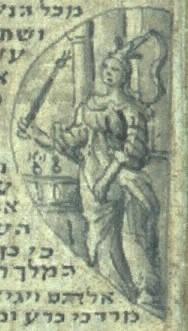Obj. ID: 39592 Bryn Mawr College Herlingen Miniature Esther Scroll, Vienna (?), ca. 1735

| Iventory number unknown
The manuscript is preserved in good condition, although there are some edge splits on it.
Some discolorations on the membrane can be seen.
The gold paint is slightly visible.
The scroll is formed of a single sheet on which the Hebrew text of the Book of Esther is written in a minute script in rectangular columns of different widths. Eight pen-and-ink drawings showing Esther story protagonists and the narrative scenes from the Book of Esther are incorporated in the text. It seems that originally, the text was written within gold frames.
The Book of Esther in Hebrew
The text is written in 3 columns with 71 lines of different lengths.
The names of Haman's sons are written in a larger script but not in a separate column of text. They include enlarged and diminished letters.
The letter ח (Es. 1:6) is highlighted by its form and size. The letter ת (Es. 9:29) is enlarged.
Another megillah executed by Aaron Herlingen is stored at the Israel Museum in Jerusalem (see https://www.imj.org.il/en/collections/397975; accessed on 12.07.2021).
Gift of Louis E. Levinthal to the Bryn Mawr College Library.
A short note on the scroll and its images are available on https://brynmawrspeccoll.tumblr.com/post/158288046453/esther-scroll-by-aaron-wolf-ben-benjamin-zeev (accessed on 4.05.2021).
A more extensive literature on the other works by Aaron Herlingen of Gewitsch is available.










